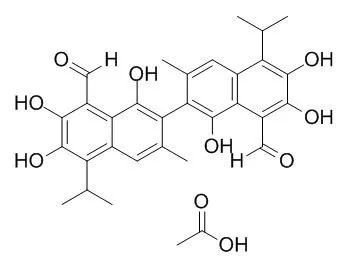| Description: |
Acetate gossypol has antifertility action. Acetate gossypol is a potent inhibitor of Bcl-2 and Bcl-xl, it has significant antiproliferative and antiapoptotic effects on multiple myeloma cells in vitro and in vivo, it also has apoptosis-inducing activity in primary cultured leukemia cells.
|
| Targets: |
Bcl-2/Bax | Caspase | Bcl-xl |
| In vitro: |
| Oncol Rep. 2013 Aug;30(2):731-8. | | Induction of apoptosis and antitumor effects of a small molecule inhibitor of Bcl-2 and Bcl-xl, gossypol acetate, in multiple myeloma in vitro and in vivo.[Pubmed: 23708869 ] | The aim of the present study was to investigate the induction of apoptosis and antitumor effects of Acetate gossypol in multiple myeloma and the possible mechanism(s) of action.
METHODS AND RESULTS:
Our results showed that Acetate gossypol resulted in a dose- and time-dependent inhibition of multiple myeloma cell proliferation, with an IC50 value to both U266 and Wus1 cells at 2.4, 2.2 μM at 48 h after treatment. Acetate gossypol effectively induced the apoptosis of multiple myeloma cells as demonstrated by typical morphological changes, DNA ladder formation and increase in the percentage of cells in subdiploid peak. Furthermore, colorimetric assays showed activation of both caspase-3 and caspase-9. Bcl-2 and Bcl-xl expression was decreased by 86.5±1.2% and 35.9±3.6%, respectively, after treatment with Acetate gossypol at 25 μmol/l for 24 h. Preliminary studies in vivo showed that a growth inhibition (T/C) of 30.9% (gossypol acetate 40 mg/kg) was obtained in Balb/C mice bearing Wus1 cells. In addition, there was no body weight loss for the treated group in comparison with the vehicle mice.
CONCLUSIONS:
Our results demonstrated that the potent inhibitor of Bcl-2 and Bcl-xl Acetate gossypol had significant antiproliferative and antiapoptotic effects on multiple myeloma cells in vitro and in vivo. Acetate gossypol may represent a promising new anticancer agent with a novel molecular mechanism and warrants further investigation as a single agent, or in combination with other chemotherapeutics, for human multiple myeloma with Bcl-2 overexpression. | | Zhongguo Yi Xue Ke Xue Yuan Xue Bao. 2009 Oct;31(5):527-32. | | Effect of gossypol acetate on proliferation and apoptosis in Raji lymphoblastoid cell line[Pubmed: 19968063 ] | To investigate the effects of gossypol acetate(Acetate gossypol ) on proliferation and apoptosis in Raji lymphoblastoid cells and explore the possible mechanism.
METHODS AND RESULTS:
Trypan blue staining and ethyl thiazolyl diphenyl-tetrazolium bromide (MTT) assay were performed to measure the effect of gossypol acetate on the growth of Raji cells. The morphologic changes were observed with Wright's staining assay. Apoptosis was identified by agarose-gel electrophoresis and annexin V-FITC marked flow cytometry (FCM) analysis. The distribution of cell cycle, apoptosis rate, and Bcl-2 protein expression were analyzed by FCM. Caspase-3 activity was detected by colorimetric assay.
Gossypol acetate inhibited proliferation and induced apoptosis of Raji cells at concentration higher than 5 micromol/L. The effects were both dose- and time- dependent. Cycle analysis indicated the alteration of cell cycle and G0/G1 arrest. The activation of Caspase-3 was observed by colorimetric assay. The results of flow cytometry showed that the down-regulation of Bcl-2 protein expression and the activation of Caspase-3 seemed to occur simultaneously.
CONCLUSIONS:
Gossypol acetate can inhibit the growth of Raji cells and induce their apoptosis. The mechanism may be related to the alteration of cell cycle and the down-regulation of Bcl-2 protein expression. |
|
| In vivo: |
| Contraception. 1992 May;45(5):493-509. | | Histopathological and biochemical effects of gossypol acetate on pituitary-gonadal axis of male albino rats.[Pubmed: 1623720] | Histopathological and biochemical effects of gossypol acetate (Acetate gossypol,GA) on pituitary-gonadal axis were investigated.
METHODS AND RESULTS:
10 and 25 mg GA/kg were administered orally to sexually mature adult male Wistar rats for 4 and 5 weeks, respectively.
STH and LTH/PRL cells showed no significant changes as compared to those of controls while TSH cells showed hypertrophy, hyperplasia and degranulation in both experimental groups. Pituitary FSH, LH/ICSH cells showed progressive regression. Gonosomatic indices of sex accessory glands at 25 mg showed significant reduction in the experimental animals as compared to those of controls. The diameter of seminiferous tubules reduced and azoospermia developed. Sertoli and Leydig cells also regressed. At 10 and 25 mg GA treatment, spermatogenesis ceased at secondary spermatocytes and spermatogonia stages, respectively. Epididymis and prostate regressed. Seminal vesicle showed no significant histological variations as compared to that of control except reduction in secretion. Biochemical observations revealed increased levels of acid phosphatase, fructose and citric acid and significant reduction in glycerylphosphoryl choline in reproductive glands of both experimental groups as compared to those of controls. Possible mechanism of antifertility action of GA is discussed. |
|






 Cell. 2018 Jan 11;172(1-2):249-261.e12. doi: 10.1016/j.cell.2017.12.019.IF=36.216(2019)
Cell. 2018 Jan 11;172(1-2):249-261.e12. doi: 10.1016/j.cell.2017.12.019.IF=36.216(2019) Cell Metab. 2020 Mar 3;31(3):534-548.e5. doi: 10.1016/j.cmet.2020.01.002.IF=22.415(2019)
Cell Metab. 2020 Mar 3;31(3):534-548.e5. doi: 10.1016/j.cmet.2020.01.002.IF=22.415(2019) Mol Cell. 2017 Nov 16;68(4):673-685.e6. doi: 10.1016/j.molcel.2017.10.022.IF=14.548(2019)
Mol Cell. 2017 Nov 16;68(4):673-685.e6. doi: 10.1016/j.molcel.2017.10.022.IF=14.548(2019)